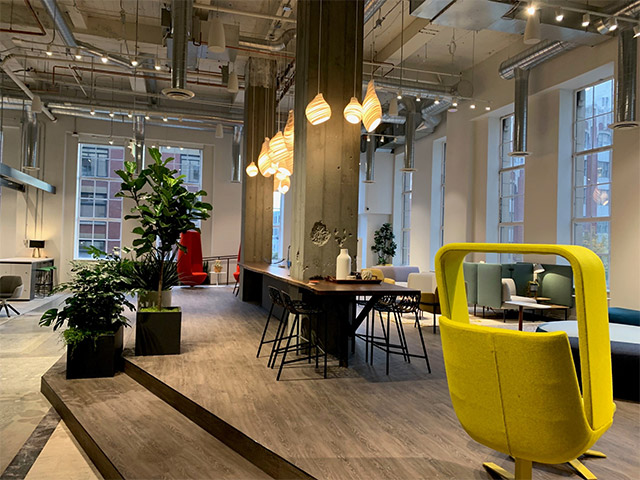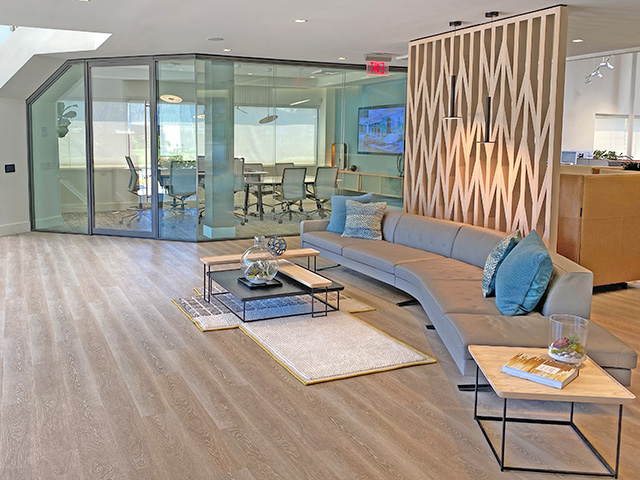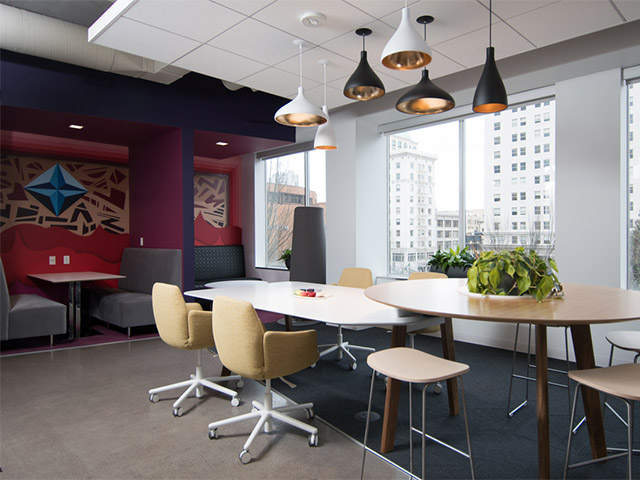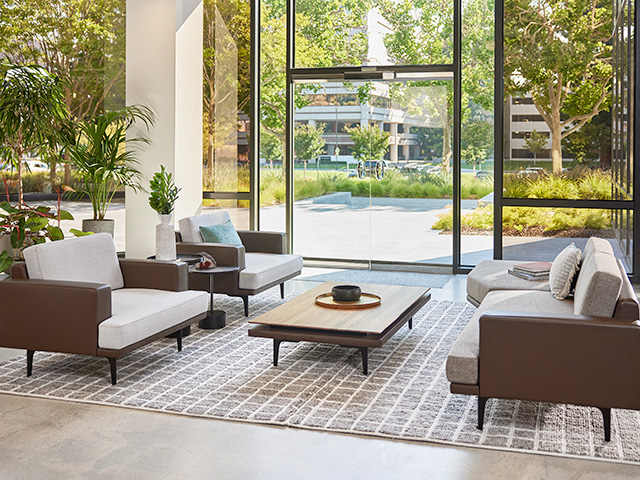Two very different behaviors optimize creative thinking for innovation processes: high-focus work and restorative activities. We need to experience these on our own as well as with others. If we never rest, can’t focus, or don't work with each other, we miss out on finding new ideas and fail to execute them. Organizations that value and design workplaces supporting all of these activities can improve their innovation efforts simply by having more ideas to consider. So how do we improve workspaces so they support independent work, collaboration, ideation, and innovation all at once?
Creating and Innovating: How Ideas Come to Market and Grow Knowledge
Before we can design for people to innovate, we need to understand how they create new ideas. Creativity and innovation are not synonymous. Researchers understand and study these as two separate concepts that work together. Creativity and innovation are both defined by novelty and usefulness—finding a new (novel) idea that is valued by others (usefulness). So, innovation starts with the discovery of creative ideas that then moves toward production or use of that idea to economically satisfy a specific need or market. If we want to optimize the front end of this process—how the individual and organization create new and useful ideas—we need to understand how new ideas come about.
Developing and Practicing Creativity
There are four stages of cognition involved in the creative process, and cycling among these stages forms a continuous feedback loop, generating novel ideas and evaluating those ideas until our ideas are fully formed and vetted. Without spending time in all of these cognitive stages, creative ideas don't happen. Luckily, we come by these fairly naturally—and by developing expertise, following the right work habits, and knowing how to combine ideas and select good ones, we can get better at it. Unfortunately, too often, our workplaces don't provide what we need for those "right work habits." Starting with creative cognition can help us fix that.
Allowing people to cycle through all stages of cognition in the creative process allows for both convergent and divergent thinking. Convergent thinking is goal-directed, narrowing, and necessary for completing tasks and making decisions. Divergent thinking is spontaneous, expansive, and necessary for making new connections across concepts and generating new ideas.
We need both focus and rest to foster the convergent and divergent thinking for the creative process, so design considerations for workplaces should include how to manage stimuli for the whole process. Remember, whether a stimulus is relevant and desired or not depends on what you want to do and which cognitive mode you need to be in: convergent or divergent.
Stimuli Sabotaging Focus
Gallup estimates that actively disengaged employees cost the US $483 to $605 billion each year in lost productivity—so it’s time to design spaces that save you money and employee energy. The challenge begins when unwanted, irrelevant stimuli divert our efforts to focus; this even includes even emotions. Too much arousal overloads our cognition. Too little interest, and we won’t pay attention enough to perform well. You may have experienced a time when your thoughts drifted off during a meeting. That may be due to not enough interest. Therefore, a good motivator is confronting achievable yet challenging tasks. It’s the “sweet spot” in terms of interest, engagement, or arousal. Since managing stimuli that doesn’t sabotage efforts to focus can be challenging, we need to protect people’s ability to focus.
Stimuli Sparking New Ideas
“Boredom,” however, isn’t always necessarily a bad thing. When our minds wander, our imagination can kick in and do some work. Being bored may be a signal that it’s time to take a break and soak in the surrounding stimuli. It could be just the right kind of stimuli that our imagination network can use to make unique and interesting connections across concepts we already know.
Oftentimes, when we want to “clear our head,” we seek a different space and activity (like a walk outdoors or daydream). When we do this, we’re letting our brains noodle on potential ideas. How many ideas have come to light when you were doing something routine, like commuting to work? Chances are your commute is very routine and you “go through the motions” with just enough awareness to get there. While on auto-pilot for routine tasks, it seems the imagination network can get some tinkering done, sometimes arriving at that flash of insight. Since our brains can do so much good stuff when we’re relaxed, we should encourage restorative behaviors at work. (While still being safe!)
Creative Rhythm and Peak Performance
It’s clear we must have both focus and rest for creative cognition. How fast we cycle between these modes of thinking and behaving depends on how well we can focus, how much rest we need, what we already know, what we need to know, and where we are in the creative process. Sleeping each night is an excellent example of a longer resting period that provides cognitive benefits for divergent thinking. In the workplace, a popular study conducted by DeskTime revealed that the most productive employees (top 10 percent), on average, took a 15-minute break after working for about an hour. The creative rhythm can also be quite fast. We’re absorbing information, generating ideas, and refining them all at once—and it’s effortless. Now, we’ve got the whole brain involved, and it seems that convergent and divergent thoughts happen simultaneously; and the executive control and default networks are cooperating instead of competing. We are in the "in-between" space between high focus and rest. There's some evidence that just the right amount of "buzz" or activity combined with the intention to do some mind wandering can help facilitate the ability to maintain enough focus and actively enlist the imagination.
Smart Design for Workplace Creativity
Considering what science says about ways to support convergent and divergent thinking, and pooling our workplace design and strategy expertise, we’ve developed a model for better understanding workplace creativity and innovation. In this model, we see, on one side, the need to protect focus work; on the other side, the need to encourage down-time, and the in-between for the creative rhythm.
For creativity and innovation to flourish, leaders should protect people’s ability to focus and encourage restorative behaviors in the workplace. Design considerations should address privacy, structure of activity, and user control, and include a variety of spaces with the freedom to choose appropriate spaces.
Knowledge Sharing: Creating and Innovating Together
If we only work alone and for ourselves, we miss out on the rest of the creative and innovative process that happens during and with knowledge sharing. We need others to build on our creative ideas and verify that they are useful for innovation to happen. So, the creative process applies to more than just the individual; it also applies to group efforts to create and innovate. What fosters creativity alone fosters creativity done together. It’s clear that we need to focus and we need to rest. At times, we need to do these alone and, at other times, we need to do them together.
When people in groups need to be creative, individual cognitive processes of creativity become externalized. Intense group focus work— "brainstorming”—and what may look like seemingly “inefficient” processes are quite helpful to creative work habits: Socializing (dining together) or engaging in off-task activities (taking an architectural tour of a city or attending a performance) oftentimes yields unexpected questions, where meaning then develops afterwards while the group makes sense of those new questions in the verification stage. Groups are less successful with innovation if their emphasis on engagement with one another is solely on one creative activity. Groups need time and space to learn, collectively, to identify the common knowledge across members, and to allow for connections between different pieces of knowledge among its members. Three well-known group processes mirror these needs: organizational learning, brain writing, and, of course, brainstorming . Much more is needed than just brainstorming. Protecting focus, encouraging restorative activities, and having the right tools for knowledge sharing become very important for group designated spaces.
Movement should be encouraged outside the group in two ways: across other internal groups and with people external to the organization. These spontaneous interactions generate knowledge sharing and learning with colleagues. These interactions allow for novel connections by affording more access to a variety of perspectives, knowledge, and expertise, both within and outside an organization.
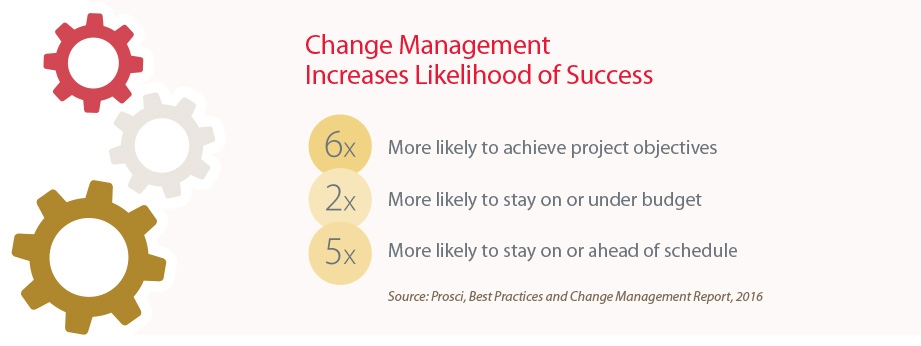
Designing for the Whole Brain
Understanding the focus, rest, and transition needs of individuals and groups leads to the following design implications for fostering creativity and innovation in the workplace.
The workspace should have full or partial privacy to block external stimuli. Focus activities tend to be highly structured for efficiency, so we also want to make efficient use of the necessary cognitive resources for high-focus activities while in a workspace. Having user control over a workspace also allows for fine-tuning that is specific to the current focus activity. Addressing the following four issues can ensure these cognitive needs are being met:
Time and spaces that promote relaxation and desired distractions from focus work are necessary. These can range from “micro-breaks”—the short pauses in focus when we gaze off into the distance and daydream—to “macro-breaks”—when we move to new spaces seeking individual or group respite and restoration. Depending on the way we prefer to recharge and how much time is needed, these spaces can range in the amount of exposure to external stimuli. User control over the space is also less critical than during focus work, but people still will need some minimal access to tools for embedding and externalizing (e.g., Wi-Fi) because, when an insight occurs, opportunity to embed is helpful before the insight is lost.
Designing for Individual Creativity
In addition to designing for high focus and rest, consider the importance of how people need to transition between these—sometimes staying in those transition spaces to capitalize on just enough privacy for focusing, combined with just enough spontaneous activity to engage the imagination.
Designing for Group Creativity
When designing spaces for groups, consider their additional needs beyond individual spaces and depending on the purpose—focusing, restoring, and transitioning.
Putting It All Together
While the degree of innovation needs may vary across different organizations, all organizations need to innovate to thrive and survive. Team members should be encouraged to span boundaries across an organization to other internal members of other groups as well as with external members at different times of the creative process. An important factor in an organization’s culture is how it is embodied in the built environment. Design solutions for an innovative culture should take into consideration individual and group creative rhythm needs, protecting focus work, and encouraging restorative activities. Given the right places, spaces, and tools for the creative rhythm of innovation, people can be free to do what they need to do to best create and innovate. When we are free to create and innovate, good things happen—for all of us.
FOR MORE INFORMATION, PLEASE CONTACT
Michelle Sample
marketing@peoplespace.com

